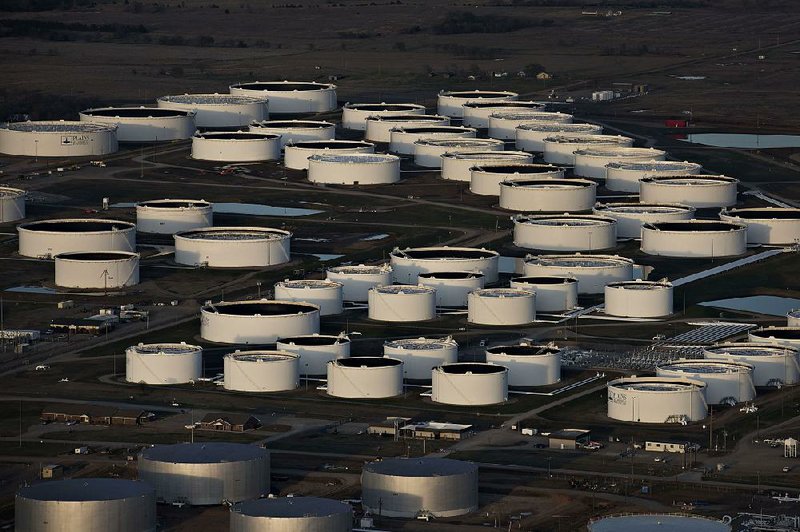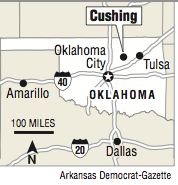For OPEC, there are few enemies more fearsome than the small Oklahoma town of Cushing.
Cushing, which prides itself as the "pipeline crossroads of the world," is the delivery point for the West Texas Intermediate crude-oil contract. At Cushing are tanks that can hold 77 million barrels of crude, enough to supply France for two months, making it the biggest oil storage hub in the U.S.
And oil inventories at Cushing are creeping near an all-time high as U.S. benchmark futures prices struggle to advance, despite the promised production cuts agreed to by OPEC, Russia and other producers.
The storage tanks in Cushing are likely to stay full as refiners park crude in Oklahoma to lower their tax bills.
For the OPEC-led efforts to boost prices, the filling up of Cushing's storage tanks is a problem.
"Part of what OPEC and in particular the Saudis want to do is drain the swamp," said John Kilduff, a partner at Again Capital LLC, a New York-based hedge fund that focuses on energy. "To do that they will reduce deliveries to the U.S. That will eventually be felt at Cushing but not in a long time."
Stockpiles rose by 1.22 million barrels last week, after a 3.78 million jump the previous week that was the biggest since 2008. The inflow of oil has pushed up the stores to 66.5 million barrels, within a whisker of the all-time record of 68.3 million set in May.
With the promise of production cuts sending prices up, that's encouraging traders and refiners to hold on to inventories, the last thing OPEC wants to see.
"The near-term prognosis for Cushing balances is not particularly rosy," said Amrita Sen, chief oil analyst at consultants Energy Aspects Ltd.
Cushing is getting more oil partly because of seasonal factors. Every year, refiners in the U.S. Gulf Coast try to reduce inventories in December to lower their tax bills, traditionally parking excess crude in Oklahoma and elsewhere. Also, U.S. refineries typically process less crude at the beginning of the year, with January demand dropping by an average of 899,000 barrels a day during the past five years.
Reductions in inventory by refineries in Texas and Louisiana "can contribute to outsized Cushing builds," said Adam Longson, a commodities analyst at Morgan Stanley in New York.
With 7,889 residents, Cushing sits about 70 miles northeast of Oklahoma City. Over the years, it has developed into the key transfer point for oil flowing from West Texas and Canada to refineries in the U.S. Midwest and on the Gulf Coast. Since late October, Cushing inventories have increased by 8.1 million barrels, largely wiping out a 9.9 million drop from mid-May to mid-October.
The Cushing overhang is putting pressure on prices for West Texas Intermediate grade oil, also called Texas light sweet, which have given up their gains after last weekend's deal between OPEC and non-OPEC nations. WTI crude prices fell Thursday below $51 a barrel, down from a peak of $54.51 earlier in the week.
The glut is also pushing the market deeper into contango, where prompt supply is cheaper than future deliveries. The discount for WTI delivered in January widened Thursday to $1.09 a barrel below February at 12:25 p.m. London. In April, when stocks were at a similar level, the spread reached $1.55.
"We may continue to see pressure at Cushing, where stocks typically move higher seasonally into year-end and keep pressure on WTI prompt time spreads," Longson said.
After the January contract expires, the growing glut may also weaken WTI during the so-called roll period, when traders can exchange physical crude for three days after the futures contract has expired. Last month, when the December contract expired, cash prices fell to $1.40 a barrel below futures, the widest spread since April.
"Once January expires you are going to see some desperate people," said Bob Yawger, director of the futures division at Mizuho Securities USA Inc. in New York, in a telephone interview. "This bearish price structure isn't going away."
The impact of the Saudi production cuts will take time as Riyadh is reducing output from January onward, and Saudi crude takes about 45 days to arrive in the U.S. after sailing from the Middle East and around Africa.
"Week-over-week inventory builds at Cushing will be noise through year-end and offer an opportunity to exploit the short-term contango conditions," said Chris Kettenmann, chief energy strategist at Macro Risk Advisors LLC in New York.
"The clock starts Jan. 1 for OPEC/non-OPEC coordinated cuts."
A Section on 12/16/2016

